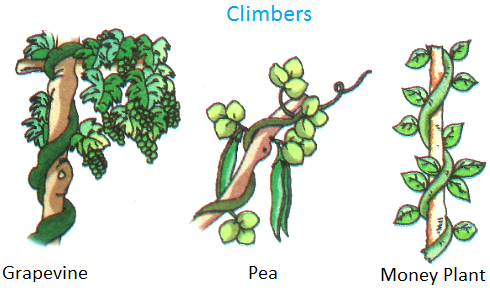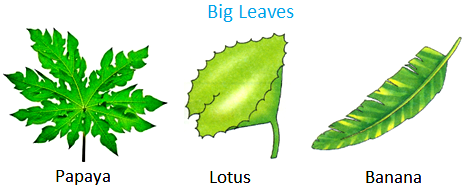Plants Around Us
We see different types of plants around us.
Plants are living things. They breathe and grow. They also reproduce. Most of the plants grow on land. Some plants grow in water. Plants are very useful to us. Some plants are big and strong. Some plants are small and weak.
Big Plants:
Tall, big and strong plants are called trees.
They have many branches.
They stand erect.
Trees have strong stem.
The stem of a tree is called the trunk. Trees give us shade, fruits and wood.
Peepal tree, banyan tree, coconut tree, etc., are big plants.
Small Plants:
Small plants are smaller than trees.
Their stems are thinner and weaker. They need lesser space to spread. They are not very tall.
Shrubs, herbs, climbers and creepers are small plants.
Shrubs:
Shrubs are smaller than trees. They have small, thin, hard, woody stem and many branches. These branches grow close to the ground. They are medium in size and they live for several years.
Rose, tulsi, jasmine, hibiscus, etc., are shrubs.
Herbs:
Some small plants have soft and green
stems. They are called herbs.Most herbs live only for a few months.
Grass, mint, wheat, sunflower, lady’s finger, etc., are herbs.
Herbs are smaller than shrubs.
They have soft, green and thin stems. They can stand erect on the ground. They are seasonal plants.
Climbers:
Stems of some plants are weak. They cannot stand erect on their own.
They need the support of another plant or sticks to stand. Those plants are called climbers. Climbers have tendrils to hold the support.Grapevine, pea, money plant, etc., are climbers.
Creepers:
Some plants crawl along the ground. They are called creepers.
Creepers have weak stem.
They cannot stand erect.
Pumpkin, water-melon, bottle gourd, etc., are some common creepers.
Thorny Plants:
Some plants have thorns. Animals do not eat such plants. Such plants are called thorny plants.
Some thorny plants are cactus, rose and bougainvillea.
Water Plants:
Some plants grow in water.
They are called water plants.
Water lily, lotus, water chestnut, etc., are water plants.
Different types of leaves of different plants around us:
Most plants have leaves. Leaves are of different sizes and shapes. Leaves are important parts of a plant.
Some plants have big leaves.
Papaya, lotus, banana have big leaves.
Some plants have small leaves.
Neem and tamarind have small leaves.
Leaves of most plants are green in color. They prepare food for plants.
Life span of plants:
Some plants like banyan tree and neem tree live for hundreds of years. Some plants like pea, sunflowers and rice live only for a few months.
From Plants Around Us to HOME PAGE
Recent Articles
-
What Is Plasma? | Blood Plasma | Proteins | Nutrients | Cholesterol
Nov 07, 25 10:29 AM
Blood is a mobile fluid which is a connective tissue and is derived from the mesoderm like cell any other connective tissue. Colour of blood is reddish and that flows inside the blood vessels by means… -
Disorders of Respiratory System | Tuberculosis | Pleurisy | Emphysema
Oct 28, 25 11:39 PM
Tuberculosis is very common disease and is caused by a type of bacteria called Mycobacterium tuberculosis. This disease causes different trouble in the respiration and infection of several parts of th… -
Regulation of Respiration | Respiratory Centres | Inspiratory Area |
Oct 14, 25 12:13 AM
Respiratory Centre is the area that controls the rate of respiration and it is observed to be located in medulla oblongata and pons. Respiratory Centre has the following will dispersed components like… -
Explain Transport of Gases | External Respiration | Tissue Respiration
Oct 09, 25 11:35 PM
In humans gaseous exchange is completed in the following ways the steps are - External Respiration or Breathing - Breathing in false taking in of Oxygen and giving out of carbon dioxide in the body. M… -
Kind and Number of Teeth | Location of Teeth in Mouth | Care of Teeth
Sep 11, 25 12:52 AM
Kind and Number of Teeth














New! Comments
Have your say about what you just read! Leave me a comment in the box below.